By Earl Ofari Hutchinson
Contributing Columnist
Los Angeles Police Chief Michel Moore has formally requested to be appointed to a second five-year term as chief.
At first glance, the reappointment seems a mere formality. Mayor Karen Bass has so far voiced no objection. The Police Commission has heaped fulsome praise on him. And some Black community activists have endorsed his reappointment.
However, there is a small cloud that still hangs over Moore and the Los Angeles Police Department. The cloud is the same one that has been there for decades. It is LAPD reform.
To be more specific, how committed is whoever sits in the LAPD top seat committed to completing the reforms needed by the Los Angeles Police Department?
Certainly, Moore’s decades within the LAPD before and during his tenure as chief mark him as the consummate insider. This fueled suspicion that he would play things strictly by the book — cautious, and always protective of the department, right or wrong.
During his first five years that was not totally the case. He recognized that things had radically changed since the days when Daryl Gates was police chief.
A chief now has term limits. There is an inspector general and a civilian-empowered Police Commission that makes policy and —unlike commissions of years past — is not merely a rubber stamp for the department.
It has made some bold, innovative and demanding policy changes in the use of force, discipline, how abuse complaints are handled, tackled the issue of racial profiling and pushed for a more inclusive LAPD from top to bottom.
Then there’s the long-standing mandate for the LAPD to change. That came from the beating of Rodney King, a devastating riot that followed, two major investigative commissions and a federally imposed consent decree that mandated sweeping department reforms.
Moore, like his immediate predecessors, was tasked with completing those reforms. There are a lot of eyes watching him to see how far and how fast he moves in completing that task.
But the one issue watched most intently to see what changes he made is the one that has caused the LAPD more headaches and scrutiny than any other. That’s the overuse of deadly force by officers in dubious and questionable encounters.
A few years back the Police Commission tackled this issue head-on when it implemented a policy change in the use of force. The change was spelled out in the preamble of the department’s official use-of-force policy.
It stated that officers “shall attempt to control an incident by using time, distance communications and available resources in an effort to de-escalate the situation, whenever it is safe and reasonable to do so.”
The change didn’t spell out the exact steps the department would take to make de-escalation a reality on the streets. Even if it did, the commission formulates policy. It doesn’t enforce it. That’s strictly in the hands of the chief.
That can be a good and bad thing depending on the chief, the circumstances, the pressure brought to bear, and the willingness to demand accountability from the rank and file.
The policy change is only the latest in a series of changes that the commission has advocated, grappled with, and implored the LAPD to make in the past few years. After the King beating in 1991 and the riots in 1992, there was much hand wringing and soul searching over how to reform the LAPD.
The aim of all of this was to transform the LAPD from the nation’s poster agency police department for out-of-control abuse, violence and bigotry to a clean, efficient, community-oriented police department.
It was more than a case of image makeover. It was a desperate need for a profound course correction in the way the LAPD did business.
The changes were soon visible. Successive LAPD chiefs disciplined, suspended and fired officers for misconduct. The use of force by officers dropped.
Citizen complaints leveled off. LAPD officials became constant presences at community events, meetings, and forums, always pushing partnership and dialogue with community leaders.
None of those things would have had the remotest chance of happening earlier. Though LAPD top brass continued to loudly protest that racial profiling didn’t exist despite legions of racially based complaints against the department, there was still the sense that the LAPD had turned the corner.
Various polls over the years have shown that more Blacks than ever have expressed guarded support for the LAPD.
While the LAPD has clearly changed, there are still some of the old troubling signs that much more needs to be done. The slaying of Valentina Orianna Peraltain in December 2021 at a North Hollywood store and the continued troubling number of officer-involved shootings are warning signs that there is still the tendency to resort to gunplay in problematic situations.
Then there is the discipline issue. Officers who misuse deadly force or commit acts of misconduct must be punished. Without it, it reinforces the notion that officers can administer street-corner justice. That is the practice that got the LAPD into so much hot water in years past.
Moore occupies the post that has been the most watched and scrutinized for the past two decades. Before reappointment, Moore can assure that the LAPD is on the right track by publicly pledging to complete all the recommended reforms.
Earl Ofari Hutchinson is an author and political analyst. He is the host of the weekly Earl Ofari Hutchinson Show on Blogtalkradio.com on Wednesdays at 9 a.m. and on KPFK 90.7 FM Los Angeles and the Pacifica Network.












